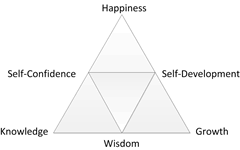Values Elicitation Triangles (VETS)
 A fellow Coach Christine Doubleday introduced this to our Coaching Network group recently as part of a CPD slot. I have seen a lot of values exercises over the years, but really liked the way this particular approach helps distill down to a core concept of what is important to us.
A fellow Coach Christine Doubleday introduced this to our Coaching Network group recently as part of a CPD slot. I have seen a lot of values exercises over the years, but really liked the way this particular approach helps distill down to a core concept of what is important to us.
The basic premise is that an investigation of values can be useful where an individual is struggling to make strategic life-career or business decisions. Greater clarity of values can help direct their choices and afford them some assurance of a degree of coherence in their strategy. This exercise helps individuals drill down to core values.
Procedure:
- Values. Brainstorm a list of six or eight important values. Some clients may find it difficult to respond to a straight question, “what are your values?” Some may find it difficult to relate to the term “values”. It may be better to ask a question such as “can you think of some words that describe what’s most important to you?” Some may find it easier to choose from a standard list. It is not important at this stage what these terms actually mean
- The first triangle. Choose the three most significant words from your list and mark these on each corner of a large triangle drawn on a sheet of paper. Having chosen three, the other words on the list are now not relevant any more (though you may find them cropping up again later in the exercise – this is also ok). Again, if a Coach is working through the exercise with a client it doesn’t matter what the coach thinks these three words mean. The individual will have their own meaning.
- The second triangle. Mark a point halfway along each edge of the triangle and write next to it a word which ‘connects’ the two words at the points of the triangle. Say you have an initial triangle with the points labelled “honesty”, “wealth”, “people”. You are now asking, “what one word can you use to describe how honesty and wealth are connected?” This word is written at the point half way between “honesty” and “wealth” along the edge of the triangle. When there is a word halfway along each edge of the triangle, the three points can be joined to make a smaller triangle within the original triangle.
- The third triangle. Repeat stage 3, and so on. In our worked example, you will be looking for what word connects “communication” and “innovation”; “innovation” and “service”; “service” and “communication”. Remember, it doesn’t matter what the coach thinks these words mean, though it might be worth asking for an explanation, if it helps the client move forward. You can keep constructing smaller and smaller triangles until you find that the words are being repeated, or that it becomes impossible to generate new words; once this is done …
- The core concept … find a word which sits in the very middle of the triangle.
Different people will use very different vocabulary and may use words that don’t look to you like “values”. Remember that it’s only the individuals’s thinking that counts.
To makes things a bit easier, I have created a simple template, Values elicitation exercise to help the individual to work through the different stages. I have only put 2 sets of triangles which probably suffice, but you can create additional triangles if needed.